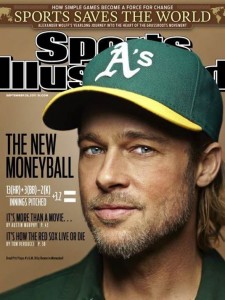 In the book, Moneyball: The Art of Winning an Unfair Game Michael Lewis reveals how the Oakland Athletics baseball team and its general manager Billy Beane crafted an analytical, evidence-based, sabermetric* approach to assembling a competitive baseball team, despite Oakland’s disadvantaged revenue situation.
In the book, Moneyball: The Art of Winning an Unfair Game Michael Lewis reveals how the Oakland Athletics baseball team and its general manager Billy Beane crafted an analytical, evidence-based, sabermetric* approach to assembling a competitive baseball team, despite Oakland’s disadvantaged revenue situation.
(*SABR refers to the Society of American Baseball Research, an entity founded in 1971 to compile information of interest to historians, statisticians, researchers and fans of the game.)
With Brad Pitt cast as the lead in this year’s movie, the story progresses through the obstacles and risks inherent when “necessity is the mother of invention.”
But to be honest, I’m less interested in the story of the first baseball team to discover the transformative power of empirical evidence than I am of the last holdout.
Look, there is no shame in not being the first person to solve a profound challenge. Undoubtedly, many people had apples fall upon their heads, but only Isaac Newton was inspired by the act to conceive of the notion of gravity.
But the world contains precious few Isaac Newtons and Billy Beanes – and far more people who firmly “know what they know” and stubbornly resist even the consideration of change.
Here in Arizona, we are less than a year into our experience with the Arizona Arts & Cultural Census/Community Database – a secure and confidential means to analyze patterns of audience participation. We’ve learned to consider this an information asset that provides powerful analytical tools which enable arts & cultural organizations to become smarter and more effective in their own efforts while revealing areas of mutual need and opportunity in their service to all Arizona communities.
The Census/Community Database is conducted via the “eMerge” technology of the company TRG Arts, which enables authorized users to conduct research and compile dynamic direct-mail lists in an environment that is highly secure and which carefully guards confidentiality and protects privacy.
So far, the Community Database tracks the arts & cultural participation of more than 808,000 unique Arizona households – which is more than 36 percent of ALL Arizona households.
We have only just begun to climb the data’s steep learning curve – but even the first few steps of the journey have been nothing short of insightful, exciting and highly impactful. (If you’d like to see what we’ve uncovered so far, you’ll find numerous postings here: http://notes.allianceforaudience.org/)
I mention this because at the start of Arizona’s community database project I was informed by the CEO of one significant organization that his company would not participate because, “we’d prefer to be guided by artistic vision rather than by statistical analysis.”
Perhaps over time his feelings – or the needs of that organization – will change. I certainly respect their right to determine their own path. But I do not believe for even one second that the choices are mutually exclusive.
I also don’t believe that any arts or cultural organization – regardless of its size, genre, location or history – can ignore that the game is now being played in fundamentally new ways.
# # #

Thank you for drawing the Moneyball analogy! I was amazed to see the “that’s the way we’ve always done it” dynamic at work in Major League Baseball, too.
As for your old-school CEO, saying that he wants his marketing “to be guided by artistic vision rather than by statistical analysis,” is like saying “we’d prefer that our concert hall be built with artistic vision rather than with engineering and detailed blueprints.”
Thank you very much, Trevor. I’ve been looking for a witty rejoinder! You nailed it!